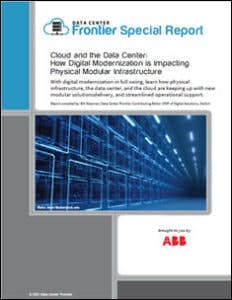How Cloud, Edge, and Connectivity are Impacting Modular Solutions
Last week, we launched a special report series on how physical infrastructure, the data center, and the cloud are keeping up with new modular solutions delivery, and streamlined operational support. This week, we’ll go beyond the cloud and see modular solutions are also impacting future designs around 5G, edge computing, IoT, and emerging cloud solutions.
Get the full report.
A lot is changing in how leaders are deploying digital infrastructure. They need to find ways to deliver critical pieces of infrastructure faster and more efficiently. It’s a big reason why designs around modular solutions are so popular. A recent report from Business Wire indicates even further growth around modular solutions in how they impact emerging technologies like cloud, edge computing, 5G, and more. Consider these findings:
- To optimize their networks and the digital services running on them, the telecom providers will need more compute and storage capacity to be deployed across carrier networks. Additionally, the increasing 4G penetration and the upcoming 5G wave further motivate telecom vendors to invest in the modular data center market for more network functionality and a much higher ability to manage networks around the edges due to increased data traffic.
- As carriers can be benefitted in terms of network service optimization, edge computing has become almost a common practice in the telecom industry. Telecom operators are estimated to deploy micro modular data centers and 5G cell towers to provide enterprises with better network connectivity across industries.
- Let’s dive a little deeper into the world of 5G, edge computing, and today’s user and workload distribution level.
A recent report from Nokia indicated that over three-quarters (77%) of respondents found the use case of connected equipment and cloud-connected robotics appealing, as they are vital enablers of Industry 4.0.
Distributing Computing: Edge, 5G, IoT, and More
As the potential next iteration of connectivity, 5G solutions have been marketed and talked about quite a lot. But is this just a marketing fad? Will these technologies hit the mainstream? The short answer is yes. Beyond 4G LTE solutions, evolution is needed to connect and share rich content and critical workloads. So, since the first 5G network went live in April 2019, there have been quite a few advancements and updates already.
According to Ericsson, towards the end of 2020, 5G numbers were already pouring in:
- 92 commercial networks in 38 countries
- 150 million 5G subscribers in China
- 320 million 5G subscribers forecasted in the US by the end of 2025
- 8 million 5G subscribers in South Korea— with close to 30 percent of the country’s mobile 5G data traffic in July 2020 being generated by only 11.3 percent of subscribers
- Six times higher 5G data usage compared to 4G subscribers in South Korea
According to Gartner, 5G was one of the main drivers for mobility in 2020, with the market for 5G infrastructure hitting more than $4 billion, with two-thirds of companies deploying 5G in 2020.
As far as real-world adoption, there have already been some pretty unique use-cases. 5G is poised to change how we game, work, and enjoy life outside of new and emerging edge solutions. For example, innovative startups find ways to leverage 5G connectivity and create diverse new use cases. This includes immersive Multiview eSports streaming to the world’s first 5G VR headset.
Here’s another vital point: A recent report from Nokia indicated that over three-quarters (77%) of respondents found the use case of connected
equipment and cloud-connected robotics appealing, as they are vital enablers of Industry 4.0.
Responding companies noted that leveraging 5G alongside connected IIOT allows them to “readily visualize the benefits of 5G for real-time monitoring and remote control of machines they can’t currently control remotely.”
All of these new trends bring to light emerging considerations around the cloud and data center balance. They also bring up new latency challenges and ensure that workloads are delivered as efficiently and resiliently as possible. This is where we get to our next point: working with partners who see this evolution and balance level.
Keeping Pace with Modular Solutions
To keep pace with this level of adoption, leaders are turning to new designs to help them stay ahead in a digital market. Mainly, they are trying to improve their speed-to-deployment to ensure they have the resources needed to keep the business ahead. The Business Wire report points out that modular data centers are at least 60% faster to deploy and provide 13% or more cost savings than traditional data center power and cooling infrastructure. Hence, modular is also helping in overcoming the rising energy crises due to growing data and data center infrastructure. This is important because North America accounts for a significant market share of data centers and is
expanding its capacity with more than 411 MW, which is currently under construction or near completion.
Before we go too much further, let’s explore the new concepts around modular and why so many are leveraging this design.
What is Modular?
For the longest time, the concept of a modular data center solution has eluded definition, if not comprehension. A description and categorization of solutions have emerged through the short history of modular solutions and vendor marketing.
A dictionary definition hints at the data center adaptation of modular:
A self-contained, fast-scaling unit or item that can be combined or interchanged with others to create different shapes or designs.
A modular data center can be defined as more of an approach to data center design that incorporates contained units, many times in the form of prefabricated modules. The modular market started with an international standard approach in the shape of an ISO (International Standards Organization) shipping container and has evolved into a market of vendors that produce everything from containers to various modular designed products and solutions for IT, power, and cooling.
In some ways, the shift in IT, such as cloud computing and edge, has been in parallel with modular data center approaches. Modular elements for both IT and the data center exist in:
Now that we understand what modular represents, it’s essential to look at the journey modular solutions have taken to get to this point.
Understanding the Modular Evolution
Although modular solutions haven’t been around for a long time, they have gone through some iterative advancements. Let’s look at the first and now second generations of modular designs.
Modular: Gen 1
The current definition of a modular data center evolved from that brief history of iterations that fall under the category of what consists of a modular solution. The idea of a modular data center is an aggregate term for the many facets that make up modular components and solutions. Some of the earliest mentions of modular solutions focused on mobility and the container.
The container data center used the foundation of an ISO standard for a shipping container and customized it to accommodate data center infrastructure. Around 2002 Google began experimenting with a container full of IT parked in an underground parking garage. Google even planned offshore barges with IT containers to use the ocean to provide power and cooling for their “water-based data center.”
APC took an early approach to modularize the data center in 2004 with the InfraStruXure Express — an on-demand, mobile data center truck with integrated power, cooling, and racks. It was primarily used for disaster recovery and temporary or transitional IT projects.
In January 2007, Sun Microsystems introduced the Blackbox data center container solution and truly kick-started the notion of a modular data center. Google and Microsoft have continued to innovate their solutions into a modular data center design. In 2008 Microsoft announced that their new Chicago data center would house up to 220 shipping containers.
This is where we pause for a second. It’s important to note that containers are not the same as modular solutions.
Container vs. Modular
Theories evolved after the early development of containers, and the hype cycle played out for a data center in a box. Numerous hardware vendors, independent companies, and data center providers embraced the modular concept and presented their engineered solutions.
Modular: Gen 2
While there are modular solutions in ISO shipping containers, the second generation of modular solutions thought outside the box (literally). These solutions kept the attributes and advantages of modularity but did not conform to just a container. A primary difference between generations was how cooling, power, and density were supplied. First-generation containers were simply a container full of IT and relied on additional infrastructure to operate. Second-generation modular solutions had integrated solutions like cooling and power and came as a complete data center solution.
Many of these solutions used advanced cooling technology, implementing evaporative cooling and efficiently using outside air.
The second generation of modular solutions also coincides with the idea of IT 2.0. This is a true expansion of the information technology area to include more WAN technologies, edge computing, IoT, more significant amounts of user density, and more data utilization. In creating a modular design, organizations are seeking not only to create a sound data center solution— they’re looking to stay agile. Prefabricated solutions designed to help off-set big workloads can help organizations move more quickly into 2.0 technologies. This includes better handling of big data, cloud computing, and a distributed global environment.
Shifting the Paradigm: All Things Modular
The idea of a modular IT solution quickly spread to the supporting infrastructure for a data center. Product manufacturers for power and cooling equipment began making modular solutions to complement modular IT deployments and act as a quick, easy and standardized way to deliver their product for traditional data centers.
UPS, flywheels, generators, and chillers — all turnkey and containerized. A modular approach to supplying power and cooling presents many of the same benefits of a modularized IT solution. While not required to be in any particular form factor, many are delivered in a containerized solution.
Consider this, a recent taken during the DCD Building at Scale conference also showed that 74 percent of data center professionals are already dealing with some type of modularization:
Download the full report, “Cloud and the Data Center: How Digital Modernization is Impacting Physical Modular Infrastructure,” courtesy of ABB to learn more about how physical infrastructure, the data center, and the cloud are keeping up with new modular solutions delivery, and streamlined operational support. In our next article, we’ll examine some new designs considerations when looking at modular solutions. Catch up on last week’s article here.
About the Author



